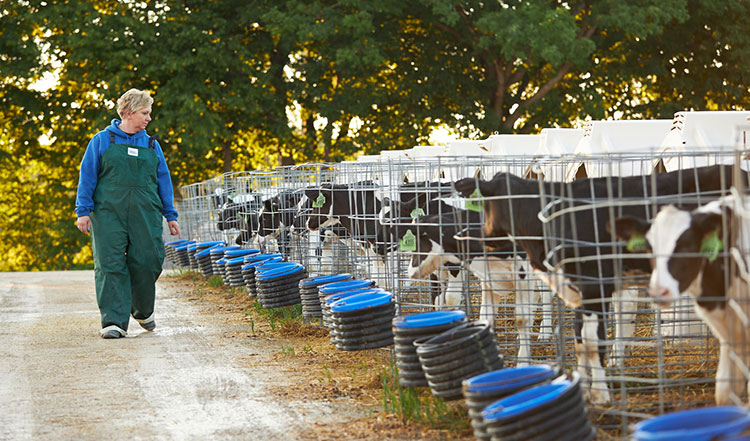
There’s a growing amount of evidence that demonstrates the importance of identifying sick calves more accurately and earlier in the course of bovine respiratory disease (BRD).1,2,3 Calves are a prey species, so they’re good at hiding behind their healthy pen mates and masking illnesses from us. If producers are not paying close attention, they can lose calves without recognizing the severity of the disease. Even those animals that survive can suffer from lifelong lung damage that curtails future health and productivity.
We rarely get a second chance with calves — respiratory disease is the source of 22.5% of deaths in unweaned heifers and 46.5% in weaned heifers.4 To improve early and accurate treatment, consider the following suggestions for BRD protocols and diagnostic tools.
Diagnostic tools
There are a number of animals that get diagnosed and treated for respiratory disease that don’t actually have respiratory disease. These calves may be showing signs of a BRD infection, but could be suffering from another condition altogether, such as Salmonella. For more accurate diagnostics, work with a veterinarian to utilize:
- Calf health scoring charts: There are two charts available that score the severity and incidence of BRD: one published by the University of Wisconsin and the other by the University of California-Davis. These visual scoring systems help producers diagnose calves more efficiently and objectively.
- Lung (thoracic) ultrasounds: An ultrasound is a great tool for detecting subclinical BRD cases, where producers can’t see visible symptoms, or to evaluate the success of BRD management changes. Many veterinarians are trained in how to perform an ultrasound on lungs, and can help identify these BRD cases earlier.
- Lab diagnostics: If a producer is unfortunate enough to have a calf die from BRD and is having a veterinarian come out to do a necropsy, they should take advantage of that opportunity to also have diagnostics performed on live calves that may be in the early stages of the disease. Relying solely on a necropsy report to identify the bacteria or viruses responsible can be misleading. It’s more than likely the culprit involved early in the course of the disease changed by the time the calf died. This is because the original pathogens that caused the infection likely depleted the immune system, and opened up the opportunity for secondary invaders.
BRD treatment considerations
Almost all BRD treatments require a prescription, so talk through your antibiotic options with a veterinarian:
- It’s important to select an antibiotic that has broad-spectrum coverage against the four BRD-causing pathogens: Mannheimia haemolytica, Pasteurella multocida, Histophilus somni and Mycoplasma bovis.
- The treatment should be proven to get to the lungs (the site of the infection) quickly, and last up to 10 days. We may already be a few hours to a half day behind on the diagnosis, and we can’t afford to wait for the antibiotic to kick in.
- Following the label is an essential part of successful treatment. Product labels contain important information, such as the correct route of administration and the right dose needed based on the animal’s weight.
Preventive metaphylaxis
Metaphylaxis is the strategy of administering antibiotics to groups of animals to prevent disease. It’s an option to explore when we know calves are going to experience stressful events, such as big weather changes or shipping, especially as it becomes more common to ship calves longer distances. However, as the dairy industry works to reduce antibiotic use, it becomes critical to understand how metaphylaxis works, and to establish a well-laid out protocol with a veterinarian.
The importance of records
Most farms do a nice job of having written treatment protocols for treating mild, moderate and severe BRD cases, but what’s often missing are the records that analyze whether or not the treatment is working. If more than 25% of calves treated for BRD need a second treatment, that tells us we’re not finding those calves early enough, or our treatment isn’t effective. We need to review these records with a veterinarian to evaluate whether or not a different antibiotic needs to be chosen, or if more attention needs to be paid to earlier diagnosis and more aggressive treatment. Sometimes, it feels easier to fix things with a syringe and a needle than to go out and fix tough management and facility issues. But we know that’s not what is best for the animal or the success of an operation in the long run.
References
1 Sivula NJ, Ames TR, Marsh WE. Management practices and risk factors for morbidity and mortality in Minnesota dairy heifer calves. Prev Vet Med 1996;27(3–4):173–182.
2 White BJ, Renter DG. Bayesian estimation of the performance of using clinical observations and harvest lung lesions for diagnosing bovine respiratory disease in post-weaned beef calves. J Vet Diagn Invest 2009;21(4):446–453.
3 Timsit E, Dendukuri N, Schiller I, Buczinski S. Diagnostic accuracy of clinical illness for bovine respiratory disease (BRD) diagnosis in beef cattle placed in feedlots: A systematic literature review and hierarchical Bayesian latent-class meta-analysis. Prev Vet Med 2016;135:67–73.
4 USDA APHIS, National Animal Health Monitoring System (NAHMS). Heifer calf health and management practices on U.S. dairy operations. Dairy 2007. Available at: https://www.aphis.usda.gov/animal_health/nahms/dairy/downloads/dairy07/Dairy07_ir_CalfHealth_1.pdf. Accessed April 6, 2020.
©2020 Boehringer Ingelheim Animal Health USA Inc., Duluth, GA. All Rights Reserved.
US-BOV-0277-2020



